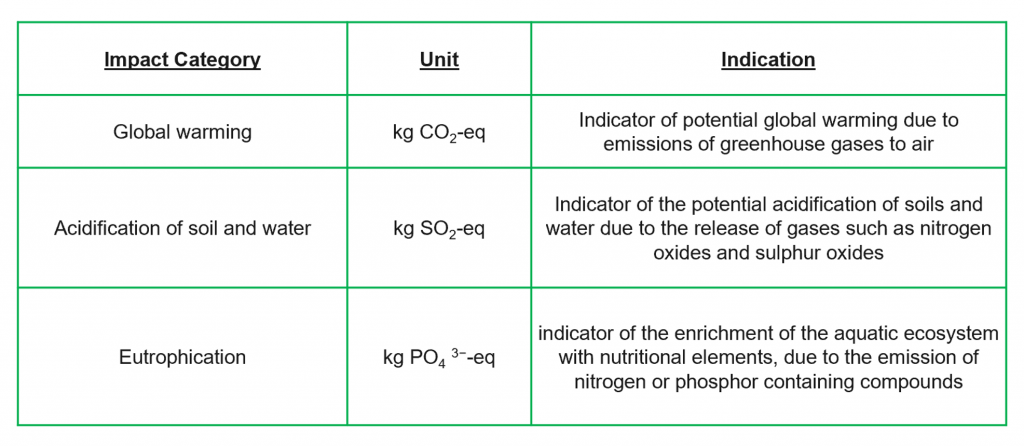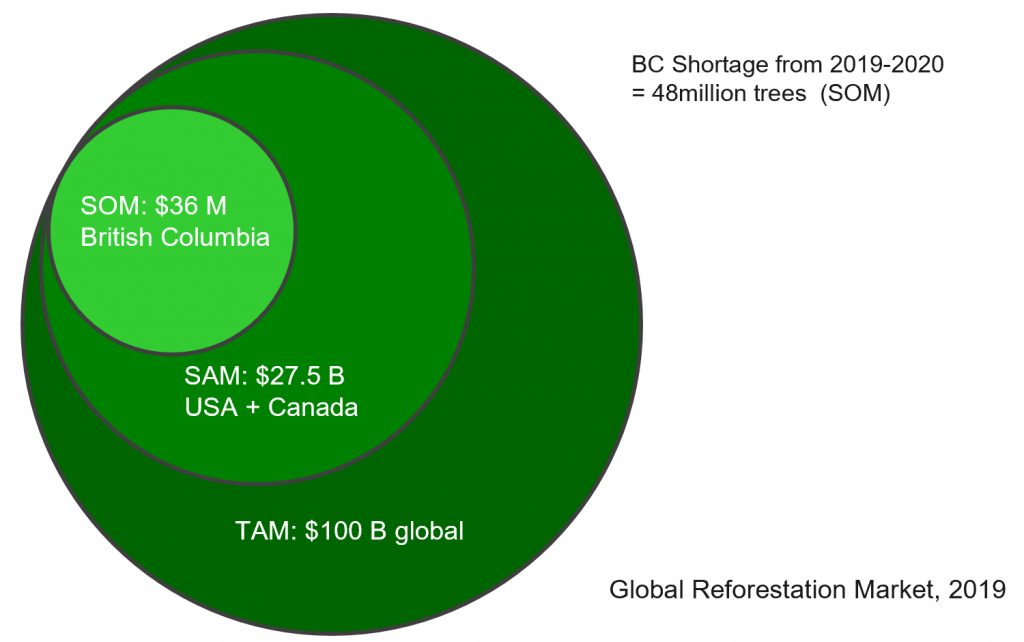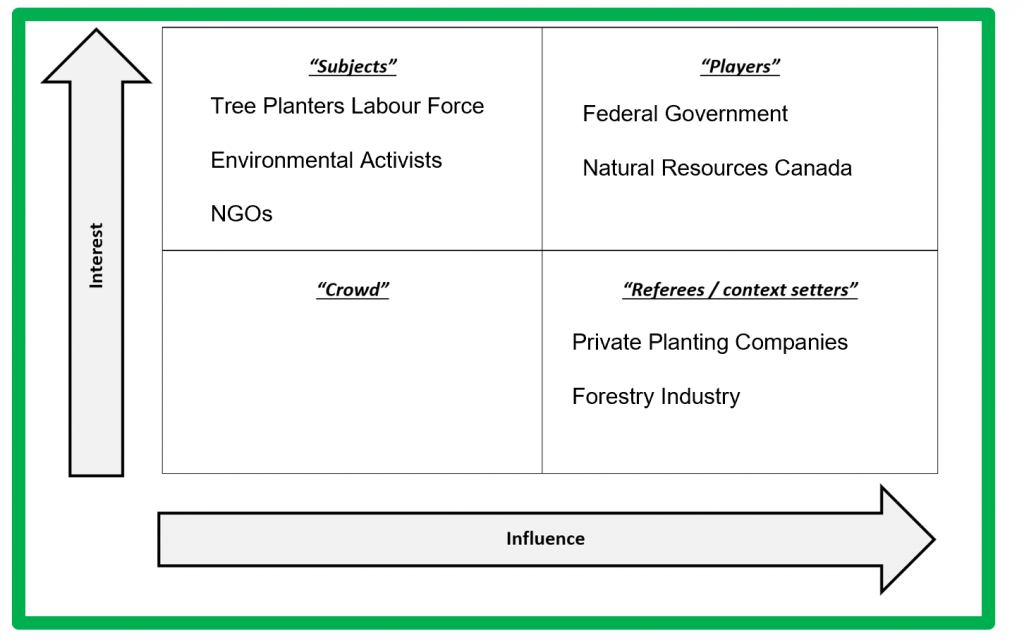Matthew Primeau, MEL Candidate | April 16, 2021
APPP 506 – Master of Engineering Leadership Capstone Project, University of British Columbia
Abstract
This project will answer the question of whether or not the pursuit of using UAV Drones in place of traditional tree-planting procedures is a beneficial idea. This project will analyze the environmental benefits, policy effects, and business market opportunity of using Drones to plant trees. Objectives of this project are to perform a comparative Life-Cycle Analysis of drone reforestation vs conventional reforestation, identifying geopolitical regions that would most benefit from switching to drone planting, analyzing the societal and political effects of drone planting, as well as identify a go-to-market strategy based on the current global opportunity for this technology. This project was mentored by Flash Forest, a Canadian UAV drone reforestation company.
Purpose & Objectives

Purpose:
Conduct a holistic sustainability analysis of Drone Reforestation, using the Triple Bottom Line approach framework of: People, Planet, Profit, in order to:
- Determine the benefits of this technology on the environment, economy, and society.
- Exercise technical, policy, and business acumen developed while enrolled in the MEL program
- Provide useful insights for Flash Forest while navigating their future business decisions and operations
Objectives:
1. Conduct a comparative Life Cycle Analysis of Drone Reforestation vs Conventional Reforestation
2. Perform Market Research on the opportunity for Flash Forests’ Drone Reforestation Technology
3. Evaluate societal effects of adopting technology, and policy levers that could be beneficial
4. Make informed recommendations for Flash Forests’ rollout strategy to maximize positive outcomes
Introduction
Between 2015 and 2020, the rate of deforestation was estimated at 10 million hectares per year. The area of primary forest worldwide has decreased by over 80 million hectares since 1990. Climate change increases the deforestation rate because tree pests and diseases such as bark beetles are becoming more prevalent. The majority of trees replanted today are by conventional hand and shovel techniques, and rates of reforestation – though varying by country – pale in comparison to the deforestation rate. Right now, current reforestation rates are only matching less than 50% of the deforestation rate.
More efficient and quality practices will need to be adopted to stop this ecological crisis, which is why I this project is being conducted. This project will seek to answer the question: is UAV Drone Reforestation a positive sustainability pursuit?
Life Cycle Analysis

Procedure for Analysis:
1.Goal and scope definition
Goal: To compare Drone UAV planting to Conventional (Hand & Shovel) practices, and determine which has the more positive environmental benefit
Functional Unit: 1 Hectare of Trees planted (Variable Tree Amount)
Scope:
- Begins at point of manufacturing of seedpods, drones, and seedlings (excluding raw material extractions).
- Ends after planting, as fate of trees past maturation can not be controlled.
- Limited to single-day planting contracts (not requiring long-term camps and overnight lodging)
- Projects located in BC, Canada
2.Inventory analysis
Primary Inputs and Outputs
Primary Inputs Analyzed: Raw Materials, Grid Energy, Heat, Chemicals, Labour, Water Usage
Primary Outputs Analyzed: Soil Contaminants, Air Emissions, Water Pollutants
Based on these inputs and outputs, the following Impact categories were determined to examine: Global Warming, Acidification, and Eutrophication

3.Impact assessment
Calculations from this project determine a significant net positive benefit (with respect to GHG emissions) of using Drone Reforestation over Conventional Practice
4.Interpretation
Largest savings are found from not having to use nurseries to grow saplings, as well as not transporting heavy pre-grown saplings to sites (potentially in distance remote areas).
Market Analysis

A strong market opportunity exists for UAV Drones. The Total Addressable Market (TAM) for reforestation is evaluated at $100 billion as of 2019, where as the Serviceable Attainable Market (SAM) for USA and Canada alone make up $27.5 billion.
Competitive Market Advantage of UAV Drone Tree Planting over conventional planting: Up to ten-times faster planting, No labour related injuries, Lower Emissions, Lower Cost
Policy Analysis
This part of the project will seek to answer what the effects of widespread adoption of UAV Drone reforestation practices would be on different stakeholders, and how its effectiveness would be evaluated on a policy basis.
Stakeholders:

- Governmental Bodies
- Private Planting Companies
- NGOs
- Tree Planters Labour Force
- Environmental Activists
The Diagram to the right displays how these stakeholders fair in terms of their respective interest and influence over drone reforestation technology policy. - Key Policy Drivers that would benefit the adoption of this technology are: financial incentives (rebates and subsidies), governmental control mandates (tree planting targets), and investment in R&D of technology in this sector
It is unlikely that an increase in Drone Reforestation who significantly effect jobs, as the amount of planting that is required to keep up with deforestation rates is incredibly high. The technology is likely to work in tandem with conventional planting, as create an opportunity for low skill labour jobs to be transitioned into high-skill technical jobs.
Regardless of the form it takes, policy implemented by governments to forward reforestation efforts are needed and on the rise. It would be wise for Flash Forest to pay attention to emerging policy decisions and base their markets of operations on that.
Conclusion
Key Insights:
- Upfront carbon emissions of planting trees via drone are recaptured shortly after trees mature.
- Technology can be deployed in areas where human access is limited due to remoteness or wildlife considerations
- Market potential is great, with distinct advantages
- Jobs for humans to tree plant conventionally likely to still exist far into future as there is massive demand for reforestation and a shortage of workers to meet it.
Based on an environmental assessment, market assessment, and policy assessment, it can be seen that using UAV Drone reforestation technology on a global scale will have net positive benefits for people, profit, and the planet when compared to conventional reforestation practices.
Acknowledgements
Special thank you goes out to the team at Flash Forest for their mentorship on this project, Cameron Jones, Angelique Ahlstrom, and Marc Apduhan.
Additional thank you goes out to Matthew’s Academic mentors, Dr. Vladan Prodanovic, and Dr. Roland Clift.
Contact

Matthew Primeau is a candidate in the Masters of Engineering Leadership: Clean Energy Engineering program at UBC, 2021.
Feel free to contact him via email: mdprimeau@gmail.com if you have any questions regarding his project.
Also, feel free to connect with him on linkedin: linkedin.com/in/matthewprimeau